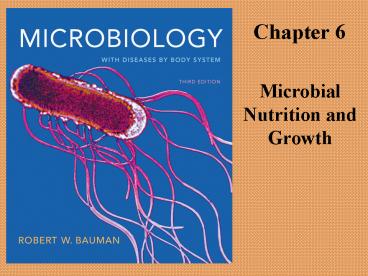Microbial Nutrition and Growth - PowerPoint PPT Presentation
1 / 21
Title:
Microbial Nutrition and Growth
Description:
Chapter 6 Microbial Nutrition and Growth * * * * Growth Requirements Microbial growth Increase in a population of microbes Result of microbial growth is discrete ... – PowerPoint PPT presentation
Number of Views:1667
Avg rating:3.0/5.0
Title: Microbial Nutrition and Growth
1
Chapter 6
Microbial Nutrition and Growth
2
Growth Requirements
- Microbial growth
- Increase in a population of microbes
- Result of microbial growth is discrete colony
- An aggregation of cells arising from single
parent cell - Reproduction results in growth
3
Growth Requirements
- Organisms use a variety of nutrients for their
energy needs and to build organic molecules and
cellular structures - Most common nutrients contain necessary elements
such as carbon, oxygen, nitrogen, and hydrogen - Microbes obtain nutrients from variety of sources
4
Growth Requirements
- Associations
- Organisms live in association with different
species - Antagonistic relationships
- Synergistic relationships
- Symbiotic relationships
5
Growth Requirements
- Biofilms
- Complex relationships among numerous
microorganisms - Develop an extracellular matrix
- Adheres cells to one another
- Allows attachment to a substrate
- Sequesters nutrients
- May protect individuals in the biofilm
- Form on surfaces often as a result of quorum
sensing - Many microorganisms more harmful as part of a
biofilm
6
Figure 6.17 Binary fission events-overview
7
Growth of Microbial Populations
ANIMATION Binary Fission
8
Figure 6.18 Comparison of arithmetic and
logarithmic growth-overview
9
Growth of Microbial Populations
- Generation Time
- Time required for a bacterial cell to grow and
divide - Dependent on chemical and physical conditions
10
Figure 6.19 Two growth curves of logarithmic
growth-overview
11
Figure 6.20 Typical microbial growth curve
Stationary phase
Death(decline)phase
Log(exponential)phase
Number of live cells (log)
Lag phase
Time
12
Figure 6.21 Schematic of chemostat
Fresh medium witha limiting amountof a nutrient
Flow-rateregulator
Sterile airof othergas
Culturevessel
Culture
Overflowtube
13
Growth of Microbial Populations
- Measuring Microbial Reproduction
- Direct methods
- Serial dilution and viable plate counts
- Membrane filtration
- Most probable number
- Microscopic counts
- Electronic counters
14
Figure 6.22 Estimating microbial population
size-overview
15
Figure 6.23 Use of membrane filtration to
estimate microbial population-overview
16
Figure 6.24 The most probable number (MPN)
method for estimating microbial numbers
1.0 ml
1.0 ml
1100
110
Undiluted
Inoculate 1.0 ml intoeach of 5 tubes
Phenol red, pHcolor indicator,added
Incubate
Results
4 tubes positive
2 tubes positive
1 tube positive
17
Figure 6.25 The use of a cell counter for
estimating microbial numbers-overview
18
Growth of Microbial Populations
- Measuring Microbial Growth
- Indirect methods
- Metabolic activity
- Dry weight
- Turbidity
19
Figure 6.26 Spectrophotometry-overview
20
Growth of Microbial Populations
- Measuring Microbial Reproduction
- Genetic methods
- Isolate DNA sequences of unculturable prokaryotes
- Used to estimate the number of these microbes
21
Case StudyCan a trip to the dentist be life
threatening?
- Details of the case
- Why do we get our teeth cleaned?
- Why does Betty feel so bad?
- What has happened?
- Will the biofilm return?
- How did they figure out Betty had septicemia?

